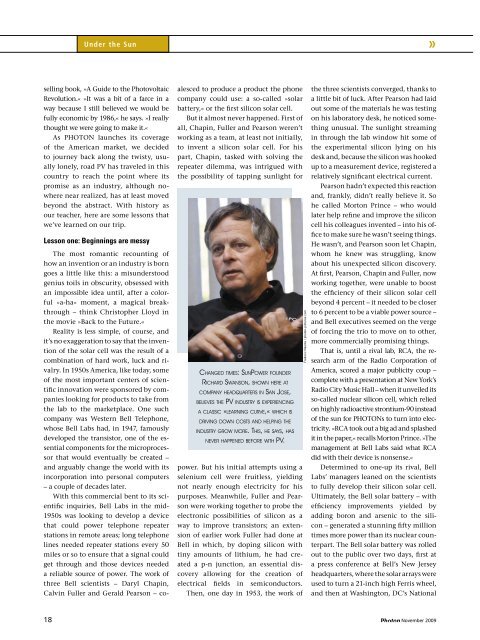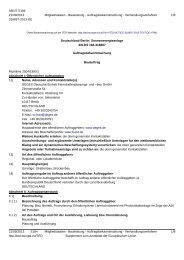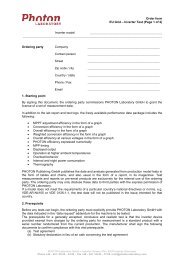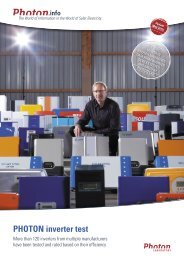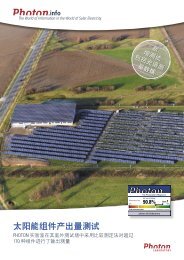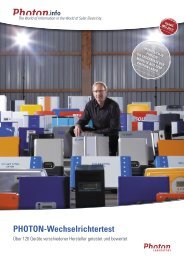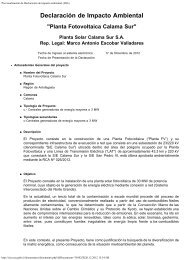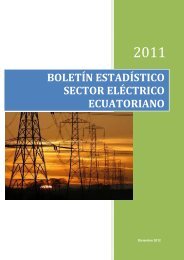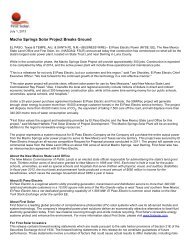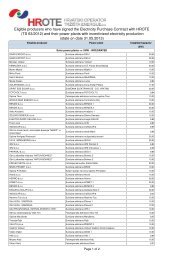INTRODUCTORY SPECIAL INTRODUCTORY ... - PHOTON Info
INTRODUCTORY SPECIAL INTRODUCTORY ... - PHOTON Info
INTRODUCTORY SPECIAL INTRODUCTORY ... - PHOTON Info
You also want an ePaper? Increase the reach of your titles
YUMPU automatically turns print PDFs into web optimized ePapers that Google loves.
Under the Sun<br />
selling book, »A Guide to the Photovoltaic<br />
Revolution.« »It was a bit of a farce in a<br />
way because I still believed we would be<br />
fully economic by 1986,« he says. »I really<br />
thought we were going to make it.«<br />
18<br />
As <strong>PHOTON</strong> launches its coverage<br />
of the American market, we decided<br />
to journey back along the twisty, usu-<br />
ally lonely, road PV has traveled in this<br />
country to reach the point where its<br />
promise as an industry, although no-<br />
where near realized, has at least moved<br />
beyond the abstract. With history as<br />
our teacher, here are some lessons that<br />
we’ve learned on our trip.<br />
Lesson one: Beginnings are messy<br />
The most romantic recounting of<br />
how an invention or an industry is born<br />
goes a little like this: a misunderstood<br />
genius toils in obscurity, obsessed with<br />
an impossible idea until, after a color-<br />
ful »a-ha« moment, a magical break-<br />
through – think Christopher Lloyd in<br />
the movie »Back to the Future.«<br />
Reality is less simple, of course, and<br />
it’s no exaggeration to say that the inven-<br />
tion of the solar cell was the result of a<br />
combination of hard work, luck and ri-<br />
valry. In 1950s America, like today, some<br />
of the most important centers of scien-<br />
tific innovation were sponsored by com-<br />
panies looking for products to take from<br />
the lab to the marketplace. One such<br />
company was Western Bell Telephone,<br />
whose Bell Labs had, in 1947, famously<br />
developed the transistor, one of the es-<br />
sential components for the microproces-<br />
sor that would eventually be created –<br />
and arguably change the world with its<br />
incorporation into personal computers<br />
– a couple of decades later.<br />
With this commercial bent to its sci-<br />
entific inquiries, Bell Labs in the mid-<br />
1950s was looking to develop a device<br />
that could power telephone repeater<br />
stations in remote areas; long telephone<br />
lines needed repeater stations every 50<br />
miles or so to ensure that a signal could<br />
get through and those devices needed<br />
a reliable source of power. The work of<br />
three Bell scientists – Daryl Chapin,<br />
Calvin Fuller and Gerald Pearson – co-<br />
alesced to produce a product the phone<br />
company could use: a so-called »solar<br />
battery,« or the first silicon solar cell.<br />
But it almost never happened. First of<br />
all, Chapin, Fuller and Pearson weren’t<br />
working as a team, at least not initially,<br />
to invent a silicon solar cell. For his<br />
part, Chapin, tasked with solving the<br />
repeater dilemma, was intrigued with<br />
the possibility of tapping sunlight for<br />
ch A n g e d t i m e s: sunpo w e r f o u n d e r<br />
ri c hA r d sw A n s o n, s h o w n here At<br />
c o m pA n y heAdquArters in sAn Jo s e,<br />
belieVes the pV i n d u s t r y is experiencing<br />
A clAssic »l e A r n i n g curVe,« w h i c h is<br />
d r iV i n g d o w n c o s t s A n d h e l p i n g the<br />
i n d u s t r y g r o w m o r e. this, he s Ay s, hA s<br />
neVer hAppened b e f o r e w i t h pV.<br />
power. But his initial attempts using a<br />
selenium cell were fruitless, yielding<br />
not nearly enough electricity for his<br />
purposes. Meanwhile, Fuller and Pear-<br />
son were working together to probe the<br />
electronic possibilities of silicon as a<br />
way to improve transistors; an exten-<br />
sion of earlier work Fuller had done at<br />
Bell in which, by doping silicon with<br />
tiny amounts of lithium, he had cre-<br />
ated a p-n junction, an essential dis-<br />
covery allowing for the creation of<br />
electrical fields in semiconductors.<br />
Then, one day in 1953, the work of<br />
Frederic Neema / photon-pictures.com<br />
the three scientists converged, thanks to<br />
a little bit of luck. After Pearson had laid<br />
out some of the materials he was testing<br />
on his laboratory desk, he noticed some-<br />
thing unusual. The sunlight streaming<br />
in through the lab window hit some of<br />
the experimental silicon lying on his<br />
desk and, because the silicon was hooked<br />
up to a measurement device, registered a<br />
relatively significant electrical current.<br />
Pearson hadn’t expected this reaction<br />
and, frankly, didn’t really believe it. So<br />
he called Morton Prince – who would<br />
later help refine and improve the silicon<br />
cell his colleagues invented – into his of-<br />
fice to make sure he wasn’t seeing things.<br />
He wasn’t, and Pearson soon let Chapin,<br />
whom he knew was struggling, know<br />
about his unexpected silicon discovery.<br />
At first, Pearson, Chapin and Fuller, now<br />
working together, were unable to boost<br />
the efficiency of their silicon solar cell<br />
beyond 4 percent – it needed to be closer<br />
to 6 percent to be a viable power source –<br />
and Bell executives seemed on the verge<br />
of forcing the trio to move on to other,<br />
more commercially promising things.<br />
That is, until a rival lab, RCA, the re-<br />
search arm of the Radio Corporation of<br />
America, scored a major publicity coup –<br />
complete with a presentation at New York’s<br />
Radio City Music Hall – when it unveiled its<br />
so-called nuclear silicon cell, which relied<br />
on highly radioactive strontium-90 instead<br />
of the sun for <strong>PHOTON</strong>s to turn into elec-<br />
tricity. »RCA took out a big ad and splashed<br />
it in the paper,« recalls Morton Prince. »The<br />
management at Bell Labs said what RCA<br />
did with their device is nonsense.«<br />
»<br />
Determined to one-up its rival, Bell<br />
Labs’ managers leaned on the scientists<br />
to fully develop their silicon solar cell.<br />
Ultimately, the Bell solar battery – with<br />
efficiency improvements yielded by<br />
adding boron and arsenic to the sili-<br />
con – generated a stunning fifty million<br />
times more power than its nuclear coun-<br />
terpart. The Bell solar battery was rolled<br />
out to the public over two days, first at<br />
a press conference at Bell’s New Jersey<br />
headquarters, where the solar arrays were<br />
used to turn a 21-inch high Ferris wheel,<br />
and then at Washington, DC’s National<br />
November 2009


